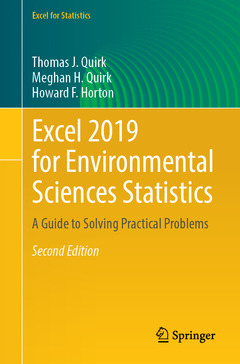Excel 2019 for Environmental Sciences Statistics (2nd Ed., 2nd ed. 2021) A Guide to Solving Practical Problems Excel for Statistics Series
Auteurs : Quirk Thomas J., Quirk Meghan H., Horton Howard F.

This book shows the capabilities of Microsoft Excel in teaching environmental science statistics effectively. Similar to the previously published Excel 2016 for Environmental Sciences Statistics, this book is a step-by-step, exercise-driven guide for students and practitioners who need to master Excel to solve practical environmental science problems. If understanding statistics isn?t the reader?s strongest suit, the reader is not mathematically inclined, or if the reader is new to computers or to Excel, this is the book to start off with.
Excel, a widely available computer program for students and managers, is also an effective teaching and learning tool for quantitative analyses in environmental science courses. Its powerful computational ability and graphical functions make learning statistics much easier than in years past. Excel 2019 for Environmental Sciences Statistics: A Guide to Solving Practical Problems capitalizes on these improvements by teaching students and managers how to apply Excel to statistical techniques necessary in their courses and work.
In this new edition, each chapter explains statistical formulas and directs the reader to use Excel commands to solve specific, easy-to-understand environmental science problems. Practice problems are provided at the end of each chapter with their solutions in an appendix. Separately, there is a full practice test (with answers in an appendix) that allows readers to test what they have learned.
Preface.- Acknowledgements.- 1 Sample Size, Mean, Standard Deviation, and Standard Error of the Mean.- 2 Random Number Generator.- 3 Confidence Interval About the Mean Using the TINV Function and Hypothesis Testing.- 4 One-Group t-Test for the Mean.- 5 Two-Group t-Test of the Difference of the Means for Independent Groups.- 6 Correlation and Simple Linear Regression.- 7 Multiple Correlation and Multiple Regression.- 8 One-Way Analysis of Variance (ANOVA).- Appendix A: Answers to End-of-Chapter Practice Problems.- Appendix B: Practice Test.- Appendix C: Answers to Practice Test.- Appendix D: Statistical Formulas.- Appendix E: t-table.- Index.
At the beginning of his academic career, Prof. Tom J. Quirk spent six years in educational research at The American Institutes for Research and Educational Testing Service. He then taught Social Psychology, Educational Psychology, General Psychology, Marketing, Management, and Accounting at Principia College, and is currently a Professor of Marketing in the George Herbert Walker School of Business & Technology at Webster University based in St. Louis, Missouri (USA) where he teaches Marketing Statistics, Marketing Research, and Pricing Strategies. He has written over 60 textbook supplements in Marketing and Management, published over 20 articles in professional journals, and presented over 20 papers at professional meetings. He holds a B.S. in Mathematics from John Carroll University, both an M.A. in Education and a Ph.D. in Educational Psychology from Stanford University, and an M.B.A. from The University of Missouri-St. Louis.
Dr. Meghan H. Quirk holds both a Ph.D. in Biological Education and an M.A. in Biological Sciences from the University of Northern Colorado (UNC) and a B.A. in Biology and Religion at Principia College in Elsah, Illinois. She has done research on foodweb dynamics at Wind Cave National Park in South Dakota and research in agroecology in Southern Belize. She has coauthored an article on shortgrass steppe ecosystems in Photochemistry & Photobiology. She was a National Science Foundation Fellow GK-12, and currently teaches in Bailey, Colorado.
Howard F. Horton holds an M.S. in Biological Sciences from the University of Northern Colorado (UNC) and a B.S. in Biological Sciences from Mesa State College. He has worked on research projects in Pawnee National Grasslands, Rocky Mountain National Park, Long Term Ecological Research at Toolik Lake, Alaska, and Wind Cave, South Dakota. He has coauthored articles in The International Journal of Speleology and The Journal of Cave and K
Written in a step-by-step, instructional format, using the Excel steps with their accompanying color screenshot figures to show the reader what should be happening on the reader's computer monitor, enabling them to solve statistics problems on their own.
Contains forty (40) statistics problems (as well as answers in chapter appendices) that are integrally related to courses in environmental sciences and statistics. These are provided at the end of each chapter, and in a practice test at the end of the volume.
Utilizes a comprehensible style, intended to be more digestible than the typical statistics text.
Date de parution : 04-2021
Ouvrage de 250 p.
15.5x23.5 cm
Disponible chez l'éditeur (délai d'approvisionnement : 15 jours).
Prix indicatif 79,11 €
Ajouter au panier


